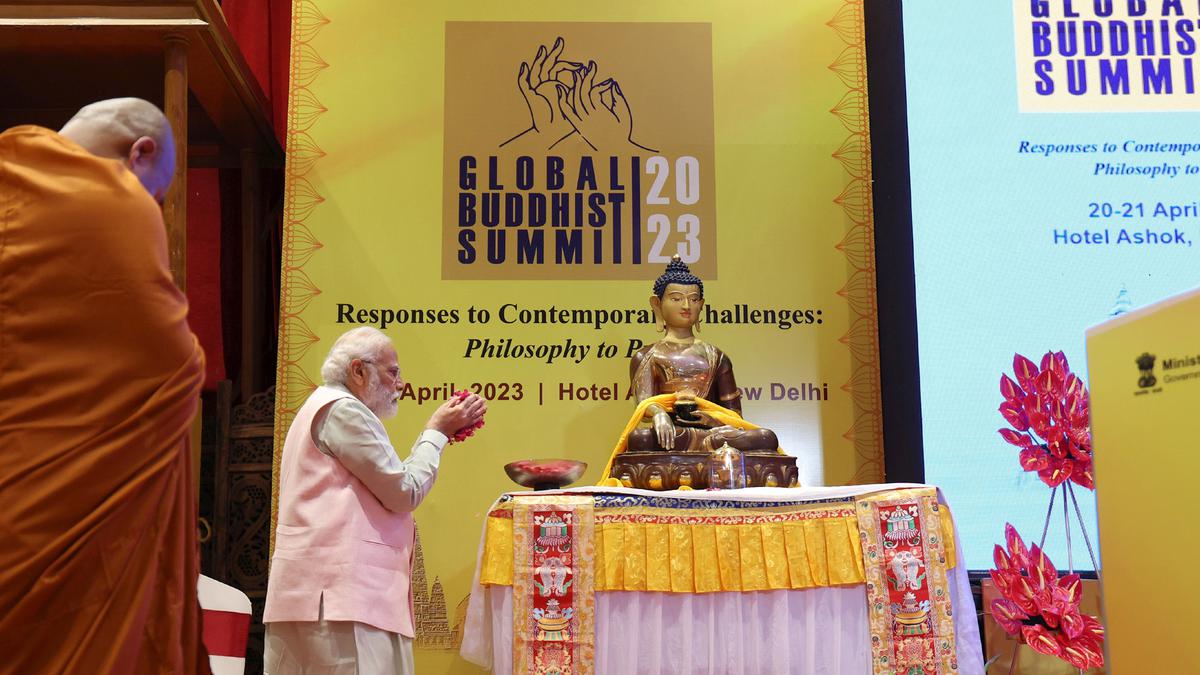The recent two-day global Buddhist summit in New Delhi provided India with an important opportunity to build its soft power and interact with the worldwide Buddhist community. India has been engaging in Buddhist diplomacy initiatives, with a focus on encouraging tourism by developing a Buddhist tourist circuit and visiting Buddhist sites during Southeast and East Asian travels.

What exactly is the Global Buddhist Summit?
- A global Buddhist summit is a high-level gathering of key figures from the global Buddhist community, such as prominent scholars, sangha leaders, dharma practitioners, and government officials, to discuss and promote Buddhism’s teachings and values while also strengthening ties within the global Buddhist community.
- The summit gives an opportunity to exchange thoughts and explore methods to address modern societal concerns informed by Buddhist ideals.
- These summits also give countries with significant historical and cultural ties to Buddhism, such as India, a platform to project and connect with the worldwide Buddhist community, so enhancing their soft power.
The Panchamrit: The current Indian government’s foreign policy guiding principles
- Samman (Respect): To establish a foreign policy based on mutual respect and acknowledgement of other nations’ sovereignty and territorial integrity.
- To promote discussion and engagement with all nations in order to overcome issues and establish understanding.
- Sahyog (Cooperation): To foster international cooperation and collaboration in order to achieve common goals and address common difficulties.
- Shanti (Peace): To promote regional and global peace and stability, as well as to work towards global disarmament and non-proliferation.
- Sanskriti Evam Sabhyata (Culture and Civilization): To foster cultural and civilizational linkages with other nations while also working to preserve and promote India’s rich cultural legacy.
During the Cold War, how did China deploy Buddhist diplomacy?
- During the Cold War, China employed Buddhist diplomacy to engage with neighbouring countries and achieve regional influence.
- China funded exchanges between Chinese Buddhist leaders and their counterparts in other countries, which frequently included the exchange of gifts and the building of cultural centres to promote Chinese culture and Buddhism overseas.
- Scholarships: China provided scholarships for foreign students to study Buddhism in China, which aided in the promotion of Chinese culture and the development of goodwill among the international community.
- Sending Buddhist delegations: China sent Buddhist delegations to international events, which aided in the promotion of Chinese culture and the enhancement of China’s image as a responsible global power.
- Promoting regional cooperation and peace: China supported Buddhism as a source of shared values and cultural legacy, which contributed to the development of a vision of regional cooperation and peace that would benefit China’s interests in the region.
- Using Buddhism to further domestic policy: During the Cultural Revolution, China promoted its own brand of Buddhism, substantially inspired by Marxist-Leninist doctrine. This interpretation of Buddhism promoted the concept of a Buddhist socialist state and was used to instill allegiance to the Chinese Communist Party.
How can India use Buddhist diplomacy to its advantage?
- India may use Buddhist diplomacy to advance its objectives and strengthen its soft power in a variety of ways. Here are some ideas for how India can accomplish this:
- Promote Buddhism at the highest levels of government: By organising high-profile events and encouraging cultural exchanges, India can continue to promote Buddhism and its rich cultural history at the highest levels of government.
- Organise cultural events: India can host cultural events that highlight its Buddhist legacy and history, as well as foster cultural interchange between India and other countries.
- Strengthen ties with major Buddhist institutions and leaders: India can endeavour to strengthen ties with significant Buddhist institutions and leaders all over the world in order to foster better partnerships and greater cooperation.
- Use Bollywood to promote Buddhist heritage: By producing films and television series that highlight the importance of Buddhism and its part in Indian history and culture, India may use Bollywood’s reach to promote its Buddhist heritage.
- Collaboration with the Indian Council for Cultural Relations (ICCR): The Indian Council for Cultural Relations (ICCR) may play an important role in promoting cultural events both within and outside of India, and India can work with ICCR to boost its Buddhist diplomacy initiatives.
- Build the Buddhist tourist circuit: By investing in infrastructure and marketing Buddhist pilgrimage sites, India can continue to build the Buddhist tourist circuit in order to encourage tourism and cultural exchange.
- Strengthen links with the worldwide Buddhist community: By participating in international events and fostering greater understanding and cooperation among nations, India may continue to strengthen its ties with the global Buddhist community.
@the end
India must take action to ensure that it continues to play an important role in the global Buddhist community. As the first diplomat of peace, Buddha’s teachings of peace and cooperation can serve as a guiding light for Indian diplomacy on the global stage, particularly in these trying times.
Source: https://www.thehindu.com/opinion/op-ed/buddhism-indias-soft-power-projection-tool/article66827769.ece
